#pictish carving
Explore tagged Tumblr posts
Text

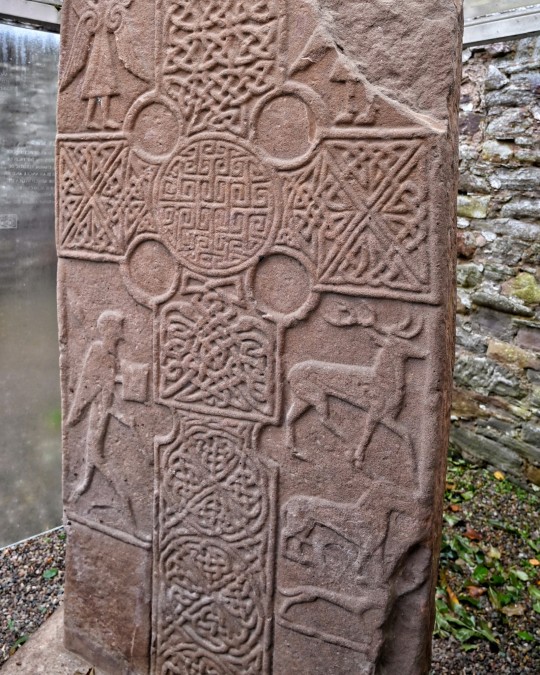


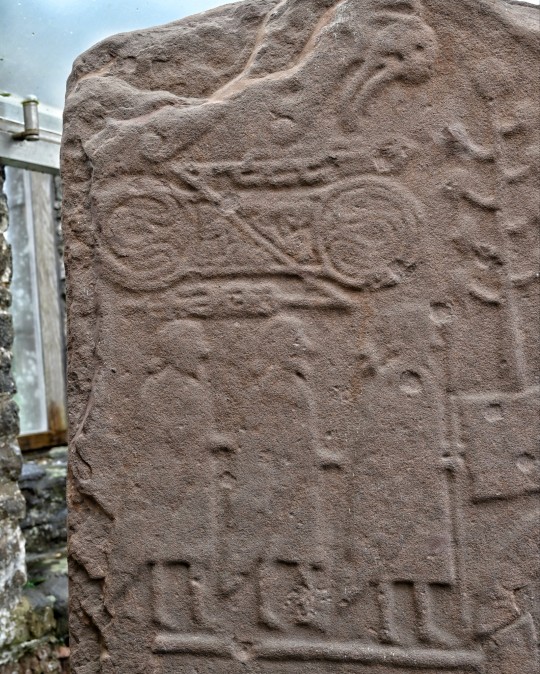




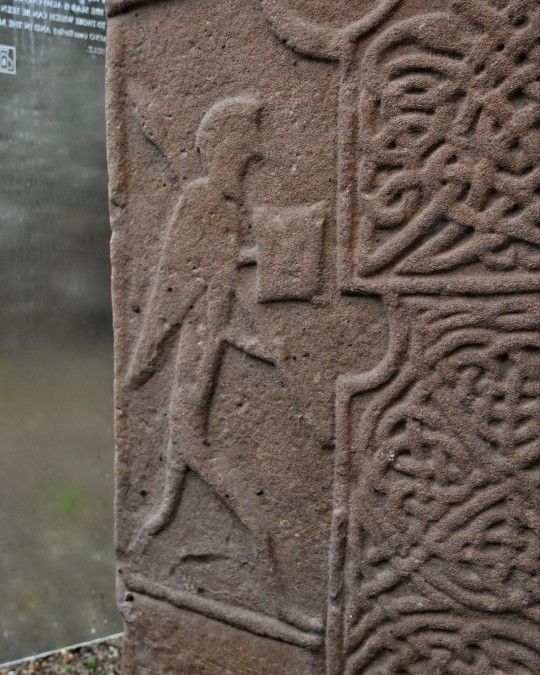
Eassie Pictish Symbol Stone, Eassie, Scotland
#pict#Pictish#pictish art#pictish stones#cross slab#early belief#early living#early religion#Scotland#outdoors#landscape#stonework#symbols#archaeology#relic#knotwork#stone carving
647 notes
·
View notes
Text

can I get a vibe check on this sticker sheet
#stickers#sticker sheet#paleoart#tullimonstrum#anomalocaris#helicoprion#ophthalmosaurus#trilobite#cephalapsis#basilosaurus#ammonite#dunkleosteus#watercolor#art#artist#inspired by pictish animal carvings#bigeelsart
74 notes
·
View notes
Text

54 notes
·
View notes
Text
The Location of King Bridei’s Fort: New Clues from Adomnán’s Life of Columba?
By Fiona Campbell-Howes In my talk for NOSAS in October, I spent some time discussing the episodes in Adomnán’s Life of St Columba (hereafter the Life) in which the holy man visits the Inverness area, which Adomnán locates in provincia Pictorum, in the province of the Picts. For this blog I want to take a closer look at those episodes. In particular, I want to see if they contain any…
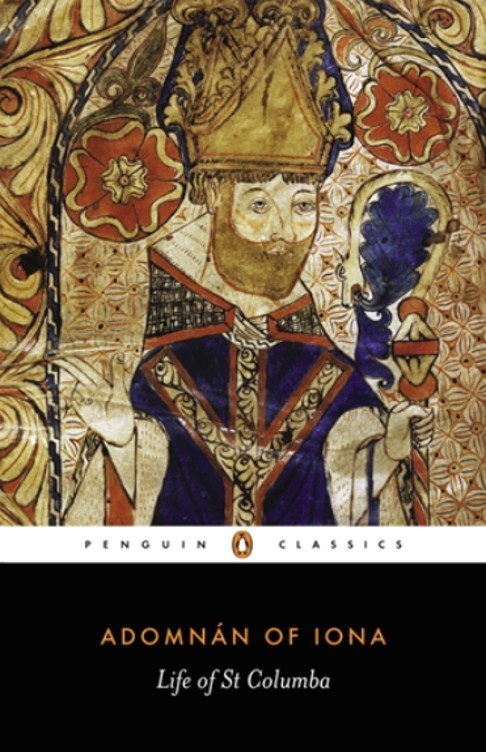
View On WordPress
#Adomnán#Alan Small and Barry Cottam#archaeology inverness#Bridei mac Maelchon#Broichan#Craig Phadrig#culduthel#Cullaird#E ware pottery#Elizabeth and Leslie Alcock#Glenurquhart#Inverness Castle hill#Inverness Field Club#Isabel Henderson#King&039;s Seat#Kingsmills#Knocknagael#Life of Columba#Luigne moccu Min#Mary Peteranna#Old Statistical Accounts of Scotland#pictish archaeology#Pictish bull carving#rhynie#River Ness#Rosemarkie Monastery#Scotland&039;s Early Silver#Steve Birch#Torvean Hillfort#Torvean silver chain
0 notes
Text

A remarkable archaeological discovery has been made in Moray, Scotland, where a Pictish ring, estimated to be between 1,000 and 1,500 years old, was uncovered. The ring, believed to be of significant historical and cultural value, offers a rare glimpse into the Pictish people, an ancient Celtic group known for their distinctive art and traditions. This discovery is especially important because Pictish artifacts are relatively scarce, making this find an extraordinary contribution to our understanding of Scotland's early history.
The Pictish ring was unearthed during an excavation in a rural area of Moray, with experts suggesting that it may have been part of a burial or ceremonial site. The craftsmanship of the ring, with its intricate designs and symbolism, sheds light on the advanced skills of the Pictish people. Archaeologists are excited about the potential for further discoveries in the area, as it may help to fill in gaps in the history of the Picts, a society that left few written records but is known for their stone carvings and enigmatic symbols.
As researchers continue to study the ring, its exact purpose and significance remain subjects of ongoing speculation. Some experts believe it may have had a ritualistic or spiritual function, possibly related to Pictish beliefs or ceremonies. The discovery of such an artifact provides a rare opportunity to examine the material culture of the Picts, offering a tangible connection to a civilization that once thrived in what is now Scotland over a millennium ago. This find is a testament to the enduring mystery of the Picts and the potential for future discoveries to further enrich our understanding of their legacy.
95 notes
·
View notes
Text



St Madoe's Stone , Perth Museum.
The most complete of all the pictish/Celtic stoones I saw on display on Monday, this was found lying down in St Madoes Churchyard, Perthshire during 1830's. . In the 1920s it was moved, in its base, to stand against the wall beside the church door. In the 1990s it was taken to Perth Museum & Art Gallery.
One side, as seen in my gif, is dominated by the ring-headed cross that fills what we can accept as the front of the slab. It is surrounded by biting dogs and with two lion-like creatures facing each other across the top of the stone.
The other side of the slab shows three cloaked and hooded riders, probably churchmen (possibly a reference to the road and its users between St Andrews and Scone) and below them three Pictish symbols: a crescent and v-rod, a double-disc and z-rod and a Pictish beast. The symbols are much worn due to exposure to the elements when it stood in thechurchyard.
In the first thousand years AD, the country we now call Scotland was dominated by changing groups of Celtic peoples, most notably the Picts. From AD 250-900, they controlled most of Scotland north of the River Forth. We do not know what they called themselves. The Picts – meaning “the painted ones” – is the name the Romans gave them. Their language has disappeared and no Pictish manuscripts are known to have survived. But their art does survive on over 300 pieces of carved stonework and a much smaller number of portable objects such as jewellery.
There at least 17 sites around the Perth area, they include Stone Circles, a Pictish Free-Standing Cross, Pictish Symbol Stones and stones with cup marks, cup and ring marks are by far the most common motif, if you remember, or have ever inspected the Caiy Stone, at Oxgangs, which I visited and posted pics of last year, there are 6 of thes type of marks on this stone.
Perth Museum has several fragments of smaller stones which I shall post at a later time.
#scotland#scottish#history#Perthsire#Perth#Perth & Kinross#Celtic Stone#Celtic Cross#Perth Musem#My pics
96 notes
·
View notes
Text
Black Butler & Celtic Legend Part 1 - The Omen of The Dragons
Alright y'all, back on my medieval French Celtic literature shit. Excuse my ADHD ass hopping from theory to theory. I'm excited and sad about this one as it's my prediction for Undertaker's final fight - and it's not looking so good 😞
In Part 2 of my French Crown Jewels Series I theorized that Undertaker is in possession of some of the gemstones he recovered from the Order of the Golden Fleece insignia for Louis XV. This contains, among other gems, the original diamond from which the Phantomhive family ring was made (referred to as The Hope Diamond in season 1 of the anime). I theorized that within the insignia, Undertaker is represented by le Côte-de-Bretagne, the spinel carved into a red dragon.
And I think Undertaker is also represented by the red dragon in the Arthurian tale of King Vontigern and his construction woes - The First Legend of Merlin.
In this legend a monarch is attempting to build a tower above a pool of water, and when the foundation fails each night, he's advised that in order to successfully build the tower he must sacrifice a half-human child. However upon digging into the foundation he finds two dragons fighting, one representing the native Britons, the other representing the invading Saxons...

LET'S TALK ABOUT DRAGONS BABY.
Usual disclaimer - I have not been able to find evidence of this legend being discussed before in relation to Black Butler. Please tell me if it has.
A Very Brief & Simplified History of Brittany
First off, I want to clarify a few things about Brittany, France, just in case anyone's confused. If you're not confused about the relationship between Britons and Bretons, feel free to skip this part!
Brittany (French: Bretagne) is a peninsula, historical country and cultural area in the north-west of modern France, covering the western part of what was known as Armorica in Roman Gaul.
In the 6th century, Celtic people (Britons) fleeing the Anglo-Saxon invasion immigrated from Great Britain to Brittany, which was then a part of Armorica (meaning land by the sea).
By the 11th century, Brittonic-speaking populations had split into distinct groups: the Welsh in Wales, the Cornish in Cornwall, the Bretons in Brittany, the Cumbrians of the Hen Ogledd ("Old North") in southern Scotland and northern England, and the remnants of the Pictish people in northern Scotland.
So by the 11 century, the Britonic people have separated into distinct cultural and geographical groups, and have developed their own distinct languages - but the Welsh, Cornish, and Breton people all descend from the same ethnic group, the people who had inhabited the British Isles since the iron age (800 BC) and spoke Brittonic. The Irish, Scottish, and the Manx (those who inhabit the Isle of Mann) descend from those who spoke Goidelic (Gaelic).
Brittany became an independent kingdom and then a duchy before being united with the Kingdom of France in 1532 as a province governed as a separate nation under the crown. Brittany is the traditional homeland of the Breton people and is one of the six Celtic nations, retaining a distinct cultural identity that reflects its history.
When Undertaker was alive in the 14th century, Brittany was ruled by the Dukes of Brittany. In 1532 they officially became a part of France, but they've always retained a unique identity and there is a strong separatist movement today to seek further independence from France. Brittany is sort of the 'Québec' to France's 'Canada'.
The most relevant information to know is that before the middle ages, the people who inhabited the regions now known as Wales and Brittany shared a heritage and a common tongue. The legend of King Arthur takes place in both England and Brittany (I believe the Isle of Avalon in the world of Black Butler will be off the coast of Brittany) and Arthur and his companions are important historical/mythological figures in both Welsh and Breton culture.
Historia Regum Britanniae
I am going to focus on analyzing the Omen of the Dragons as it appears in The History of the Kings of Britain or Historia regum Britanniae, a work of historical fiction that was written in the 12th century. It chronicles the lives of the Kings of Britons from the founding of the British nation up until the Anglo-Saxons assumed control of much of Britain around the 7th century. Historia regum Britanniae is one of, if not the central piece of The Matter of Britain, a body of medieval literature associated with Great Britain, Brittany, and their legendary kings and heroes, particularly King Arthur. The lais of Marie de France, one of which I detailed in my Rossignol theory post, are also part of The Matter of Britain.
The First Legend of Merlin as portrayed in Historia Regum Brittanie
The First Legend of Merlin revolves around the characters of the half-human boy Merlin/Ambrosius and the Monarch, King Vortigern.
It should be noted that this legend is sourced from an already existing story and that the figure of Merlin is imposed onto the real life 5th century historical figure Ambrosius Aurelianus. Ambrosius was a war leader of the Romano-British who won an important battle against the Anglo-Saxons.
King Vortigern himself was a native Briton, but he is portrayed to be a betrayer of his own people - or at the very least, an easily manipulated fool. He invited the Saxons to England - brilliant fucking idea, mate - and married a Saxon.
Vortigern was a 5th-century British ruler best known for inviting the Saxons to Britain to stop the incursions of the Picts and Scots and allowing them to take control of the land. He is regularly depicted as a villain or, at best, weak-willed and unable to control the Saxons once he arranged for, or encouraged, their arrival in Britain.
In the legend, King Vortigern has lost all his other fortified holds, so he asks his advisors/ 'magicians' for advice and they tell him to build another. Seems kind of obvious to me... Except all work that they do vanishes overnight.
At last he had recourse to magicians for their advice, and commanded them to tell him what course to take. They advised him to build a very strong tower for his own safety, since he had lost all his other fortified places. Accordingly he made a progress about the country, to find out a convenient situation, and came at last to Mount Erir, where he assembled workmen from several countries, and ordered them to build the tower. The builders, therefore, began to lay the foundation; but whatever they did one day the earth swallowed up the next, so as to leave no appearance of their work.
So Vortigern asks the magicians and they advise him to take the next logical course of action - child sacrifice, my liege, duh!
Vortigern being informed of this again consulted with his magicians concerning the cause of it, who told him that he must find out a youth that never had a father, and kill him, and then sprinkle the stones and cement with his blood; for by those means, they said, he would have a firm foundation. Hereupon messengers were despatched away over all the provinces, to inquire out such a man.
Now, at this my ears perked up like a fucking dog's. A youth that never had a father - that's a phrase that sounds like it could have been subjected to many a translation. After all, what does a child that never had a father mean? A child who was hatched from an egg? A kid whose dad went out to buy cigarettes and never came back? An orphan? A bastard? A child whose father was dead before they were even conceived?
Sure enough, when I scrounged around for another translation:
“The child must be borne of both woman and demon.”
And yet another interpretation merely states that the child cannot have a "mortal father".
His wizards claim that only by mixing in the blood of a child who has no mortal father will he make the foundations sound.
Ancient engineering is a trip, eh? I so love living in a time where we don't rely on mixing the blood of children into our concrete to prevent a sinking foundation.
Now, as to what Vortigern was attempting to build... Sometimes it's a "fortress", sometimes it's a "citadel", but most often the translation reads as a "tower". Another aspect of the legend remains consistent - the construction is always occurring either above or next to a body of water.
So a monarch is trying to build a structure (a tower over water), and is mysteriously unable to begin his project. His advisors tell him in order to proceed, he must sacrifice a child - one sired by a non-mortal upon a mortal woman.
Monarch/Warlord = King Vortigern = Queen Victoria
Structure over water = tower above pool = Tower Bridge over the Thames
Monarch's advisors = Vortigern's magicians = John Brown
Half-mortal child = Ambrose/Merlin = Vincent Phantomhive
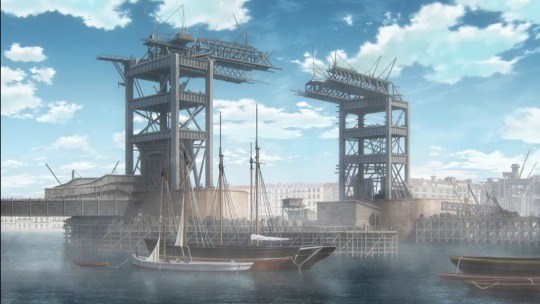
Tower bridge under construction in 4x11
It's long been speculated that the events of December 14th, 1885 (namely, the murder of Vincent Phantomhive) are connected to the Tower Bridge, a project Prince Albert took a particular interest in. It began construction on April 22, 1886 (around four months after Vincent's murder) and is referenced several times in the manga...and in season 1 of the anime, the unfinished bridge is where the final confrontation between Sebastian and Ash/Angela takes place.


Sebastian & the angel Ash on the unfinished Tower Bridge in 1x24. Souls forming a seal above the bridge while the city of London burns in 1x24.
The bridge in the anime is built with/contains human sacrifices, and Sebastian states in all likelihood it was Ash/Angela (the advisor) who instructed Victoria (Vortigern) to build the bridge.
Ash states that "no demon must be allowed to enter through this gate" and that soon "all of eastern London will be safe from impurity". Eastern, specifically 👀 remember this for later...
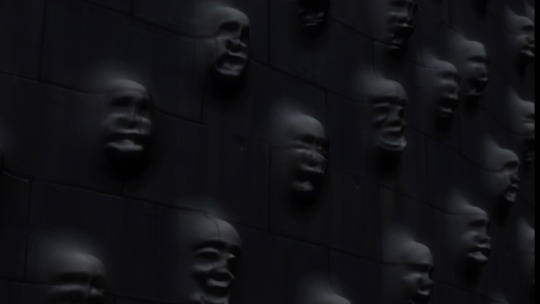
Horrible CGI human sacrifices in the bridge's foundation in 1x24
Back to the legend - the kings advisors go searching and find such a child who has no father, a boy whose mother claims to have laid with none other than a being who had long haunted her before lying with her in the shape of a beautiful young man. The king consults his advisor, who tells him that Merlin's father was likely an incubus.
For, as Apuleius informs us in his book concerning the Demon of Socrates, between the moon and the earth inhabit those spirits, which we will call incubuses. These are of the nature partly of men, and partly of angels, and whenever they please assume human shapes, and lie with women. Perhaps one of them appeared to this woman, and begot that young man of her."
Further versions of the legend add that Merlin/Ambrose is actually created as the antichrist. However Merlin is never portrayed as a malevolent force; having been baptized by his mother, he is freed from the Devil's influence, and yet still has the kick-ass powers. You get the best of both worlds, I guess.
The Omen of The Dragons
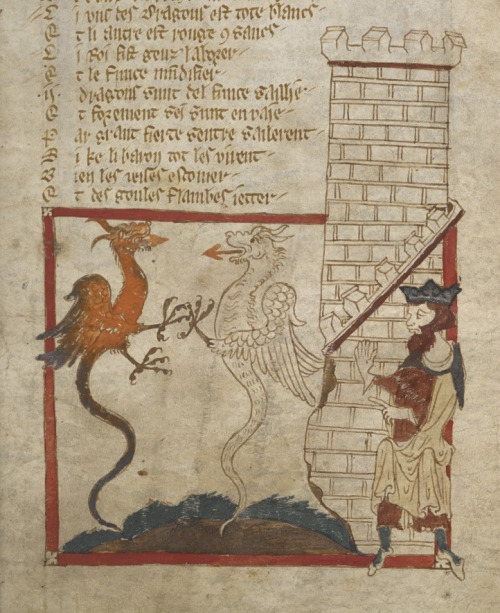
Merlin speaks with the king and when he finds out his intent is to sacrifice him, he reasonably suggests to him and his followers that before you go around sacrificing children maybe you should take a look at what's underneath the tower! And for this, they name him a prophet. Turns out common sense is magical! So they dig up the ground, and they find a pond underneath the tower which has been the cause of the foundation sinking.
Then said he again to the king, "Command the pond to be drained, and at the bottom you will see two hollow stones, and in them two dragons asleep." The king made no scruple of believing him, since he had found true what he said of the pond, and therefore ordered it to be drained: which done, he found as Merlin had said; and now was possessed with the greatest admiration of him. Not were the rest that were present less amazed at his wisdom, thinking it to be no less than divine inspiration.
Lo and behold, when they look they find two dragons, just as Merlin had predicted. The translation here is a bit misleading - the true spirit of Vortigern's reaction seems to be more along the lines of fearful reverence - he and his men were intimidated by Merlin/Ambrose's abilities.
The dragons, one red and one white, wake and fight each other with fire over the lake as the king looks on.
As Vortigern, king of the Britons, was sitting upon the bank of the drained pond, the two dragons, one of which was white, the other red, came forth, and approaching one another, began a terrible fight, and cast forth fire with their breath. But the white dragon had the advantage, and made the other fly to the end of the lake. And he, for grief at his flight, renewed the assault upon his pursuer, and forced him to retire.
So the white dragon, who represents the Saxons, triumphs over the red dragon, who represents the Britons. They fight over a body of water, and cast fire with their breath. In the end, the white dragon defeats the red dragon.
I fear this does not bode well for Undertaker.
Undertaker's Fate
Within the insignia for the Order of the Golden Fleece of Louix XV, the Spinel carved into a red dragon is literally called "the coast of Brittany". Here, the red dragon represents the Brittonic people from whom the Bretons descended. Undertaker is the Celtic dragon.
As for the white dragon, who represents the Saxons - I believe this will be John Brown, servant of Queen Victoria. Queen Victoria is herself descended from the Anglo-Saxon regime of England, her mother was a Saxon, as was her husband/cousin Prince Albert. Worth noting that king Vortigern, though a native Briton, married a Saxon.
Undertaker has outright stated that he does not care for Queen Victoria - but there are hints in the events of his past that his feelings towards her are a bit more strong than dislike. I think it's more accurate to say he hates her guts, especially after Claudia's death.
Queen Victoria was born in May of 1819. The massacre at Reaper HQ (a far cry from Undertaker's previous behaviour working as a reaper) likely occurred in 1819 as well. This was also the year in which the name "Cedric" first appeared in the newly published novel 'Ivanhoe'. May 1819 was also when Keats wrote "An Ode to a Nightingale", which is the cornerstone of my "Rossignol" last name theory. 1837 is the year in which Queen Victoria ascended to the throne - this lines up with the date when Undertaker officially deserted the reapers, taking his death scythe with him. 1847 is also the year of death for Undertaker's first chronological locket, Molly G.
These dates aligning link Undertaker's rebellion against his superiors to Victoria's rise to power. However, a 1v1 of Grandma Vicky vs Grandpa Reaper probably wouldn't be all that compelling of a fight.
Enter Queen Victoria's servant (in real life, and in the anime) John Brown.
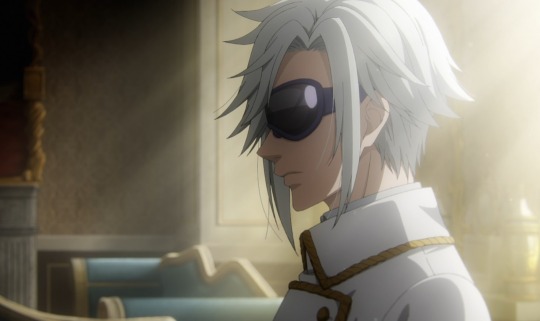
John Brown in 4x10 - Sick Shades, Bro! Not conspicuous at all!
John Brown was a real person who served Queen Victoria in the aftermath of Prince Albert's death (and there is speculation that he and Vicky had an affair). But the real John Brown died on March 27, 1883 - and as I've discussed at length, Yana seems to be deliberate in the timing of significant events in relation to real world historical figures. That the 'real' John Brown in the manga died 2 years before Vincent Phantomhive was murdered is not a coincidence - rather, I think something else assumed John Brown's identity upon his death, and may have convinced Queen Victoria that Vincent Phantomhive needed to die...
There's been a lot of speculation about what John Brown is; another reaper, a demon, or an angel*. But he is most definitely not human. Not with those fuck-ass snow goggles.
*For the record, I think John Brown is indeed an angel.
Both characters of John Brown and Ash fill the same roles as the Queen's closest protector and advisor - the 'magicians' to Victoria's 'Vortigern'. The White Dragon Undertaker fights will not literally be Queen Victoria, but John Brown - and it seems Undertaker, GOAT that he is, will have finally met his match.
I think this will be Undertaker's final act in the manga, to reenact the fight between the red dragon and white dragon over the water by the half-built tower as detailed in the Historia regum Britanniae. Undertaker will fight the Saxon dragon, John Brown...
And Undertaker will lose.
In the finale of season 1 of the anime, Undertaker is distantly involved in the fight between Sebastian and Ash/Angela on the tower bridge (while the city of London burns down around them). He teams up with the other reapers (William and Grelle, and unnamed reapers #1-4) to disconnect the 'hearts of souls' feeding Ash/Angela's power. Undertaker's actions weaken Sebastian's final opponent and enable Sebastian's victory (and therefore, Ciel's). And once again - I think season 1 provides a loose interpretation of what will happen in the manga.
His role in the manga will likely be much more significant. I think he will still team up with the other reapers, but it won't be to snip black clouds because Will agreed to waive his fucking library fines. Undertaker's going to go out fighting...
I think Undertaker will meet his ultimate demise in fighting John Brown, but in doing so, he will enable Sebastian's victory and Ciel's revenge - and perhaps also stop whatever it was he learned back in 1819 that caused his initial rebellion.
Now excuse me while I go pre-grieve 😭
Lludd & Llefelys
This isn't particularly relevant - except this peaked my interest because it sounds vaguely familiar to what I understand about the Mother3 theory, so I'm throwing it in here. In the 13th century (after Historia regum Britanniae was published) the tale of Lludd and Llefelys was written as an origin for how the two dragons came to be buried underneath the pool at Dinas Emrys.
As to how the dragons became confined there, the story of Lludd and Llefelys in the Mabinogion gives details. According to the legend, when Lludd ruled Britain (c.100 BC), a hideous scream, whose origin could not be determined, was heard each May Eve. This scream so perplexed the Britons that it caused infertility, panic and mayhem throughout the realm. In need of help Lludd sought counsel on this and other matters from his brother Llefelys, a King of Gaul. Llefelys furnished the information that the scream was caused by battling dragons. The scream would be uttered by the dragon of the Britons when it was fighting another alien dragon and was being defeated. Lludd heeded the advice given to him by Llefelys and captured both dragons in a cauldron filled with mead when they had transformed themselves, as apparently dragons did, into pigs. The captured dragons were buried at the place later called Dinas Emrys, as it was regarded as the safest place to put them.
But that's not the only way this story might relate to Mother3...
Only Two Dragons - But I Thought The Dragon Must Have Three Heads???? Wait wrong show
Two dragons not enough for you? What about Sebastian, the guy who literally loves to light shit on fire, you cry out in dismay? Doesn't he get a dragon?
Fear not my friend, I've got you covered.
There is a much lesser known prophecy that is a sort of an addendum to Merlin's prophecy. It is contained in a series of texts called The Prophecy of the Eagle, and it foretells the Norman invasion of England...

"As the White Dragon expelled the Red Dragon so a Dark Dragon will throw out the White Dragon. The Dark Dragon, fierce and terrible, will come flying and burn up the whole island with the corrupting fire of its mouth. From its loins will come forth a ram with a fine fleece that will strike with its horns in the east."
And that's where I will pick back up in Part 2, on The Prophecy of The Three Dragons! Because really, are two dragons ever sufficient?
Thank you for reading all this! If you're interested in checking out my other theories you can find a masterpost of them here. My ask box is open and I'm always happy to talk about this stuff, if you have any comments to share or questions to ask. (Note that I will answer publicly unless otherwise specified - also note that if you've asked a question and haven't received an answer yet, it's probably because I referenced this theory and wanted to post it first!)
Going to go cry into a tub of ice cream over my prediction of Undertaker's fate now, bye.
#you best believe i wrote this entire thing to a playlist of dragons tearing each other's throats out!#black butler#black butler theory#kuroshitsuji theory#kuroshitsuji#undertaker#undertaker theory#john brown#queen victoria#sebastian michaelis#ciel phantomhive#vincent phantomhive#tower bridge#Thanks for the asks everyone they really do make my day#look no one is more upset than me myself and i about my prediction of undertaker's death#but yana i adore him 😭#tower bridge theory#john brown theory#you get a theory and you get a theory!#everyone gets a theory!#undertaker x claudia#claudiataker#undertaker x cloudia#cloudiataker
29 notes
·
View notes
Text
🌳Ogam Master Post🌲
(Aicme links below)
Ogam is an Early Medieval (and the first) Celtic writing system created in 100 CE, which went on to develop Ancient Irish in the 4th-6th centuries CE, and Old Irish in the 6th-9th centuries CE. It was also used to write Pictish, Scottish Gaidhlig, and some Welsh.
The Ogham alphabet consists of four major letter groups—or aicme—to make up the feda, and one additional group that was created in the 6th century of the Old Irish period—the forfeda.
Ogham can be seen today carved into ancient stones in Ireland, Scotland, and in Wales, some dating back to the 4th century CE.
Today, each character is representative of a type of tree or plant with additional associations such as wealth, healing, love, etc (however its origin is completely separated from this idea. If you would like to use Ogam without this modernized association, feel free to do so). These characters are now used primarily in divination practices in Celtic paganism and Celtic folk witchcraft as wooden staves, cards, or carved onto stone and other natural objects. Ogam is typically written vertically from bottom to top, resembling the growth of a tree. However, it can also be written horizontally by rotating the characters 90° to the right (as shown in aicme links).
First Aicme (B)
Second Aicme (H)
Third Aicme (M)
Fourth Aicme (A)
Fifth Aicme/Forfeda (EA)
If you would like typed Ogam on a mobile or desktop device, be sure to use the horizontal format of the Ogam Transliterator. Highlight, copy, and paste the text to use in various projects.

#irish language#gaidhlig#irish history#scottish#gaelic#gaeilge#irish#ancient celts#celtic#ogham#witch aesthetic#witchblr#witch community#folk witchcraft#witchcore#green witch#witch#witches#witchcraft#druid#druidism
59 notes
·
View notes
Text
Larry Trask, the linguist + Basque expert, felt obliged to put this note at the top of his website!
"But please note: I do not want to hear about the following:
Your latest proof that Basque is related to Iberian / Etruscan / Pictish / Sumerian / Minoan / Tibetan / Isthmus Zapotec / Martian
Your discovery that Basque is the secret key to understanding the Ogam inscriptions / the Phaistos disc / the Easter Island carvings / the Egyptian Book of the Dead / the Qabbala / the prophecies of Nostradamus / your PC manual / the movements of the New York Stock Exchange
Your belief that Basque is the ancestral language of all humankind / a remnant of the speech of lost Atlantis / the language of the vanished civilization of Antarctica / evidence of visitors from Proxima Centauri
I definitely do not want to hear about these scholarly breakthroughs."
22 notes
·
View notes
Text



St Madoes Stone from Scotland dated between 500 - 700 CE on display at the Perth Museum in Perth, Scotland
This sandstone-slab features Pictish symbols and was found in 1945 during ploughing at Inchyra House, St Madoes. Carvings on both sides indicates it was supposed to be standing up and with carvings in different styles it shows it was made by a team of artists.
The symbols comprise of the double-disc, salmon, snake, tuning fork and mirror. The narrower faces are cut with strokes of Ogham inscriptions that seem to be a series of names. These are a later addition and perhaps indicate the Christianisation of the area.
Photographs taken by myself 2024
8 notes
·
View notes
Text
In 1809 work was well advanced on building the planned new village of Burghead, and, in the process, destroying much of what remained of the Burghead Promontory Fort. One problem encountered by the builders was locating a reliable source of fresh water for the village, and they decided to explore the local story of a lost well that had once formed part of the fort.
What the builders uncovered was one of the most mysterious places in Scotland. A flight of 20 stone steps led down into the ground to a square chamber, measuring 16ft or 5m square, cut into the natural rock at the base of a crag. Within the chamber was a square rock-cut tank surrounded on all sides by a ledge 3ft or 0.9m wide. The tank was 4ft or 1.3m deep and fed by water from an underground spring. While clearing out the chamber the objects recovered included a stone with a bull carved on it, one of many found in the remains of the fort (and, mostly, since lost), plus part of a Pictish stone cross and, oddly, a number of Spanish coins.
Also discovered was a semicircular pedestal on the ledge in one corner of the chamber, and a basin in another. A third corner has steps down into the tank. Having cleared out the chamber, the builders used explosives to deepen the tank in the centre to increase its capacity. They then re-cut the access steps to make them more regular and covered over the chamber with a vaulted stone roof with a ventilation hole left in its centre.



9 notes
·
View notes
Text
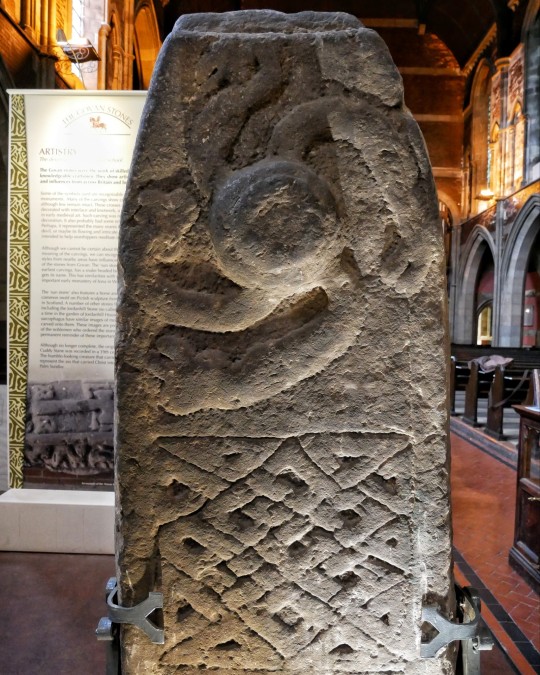
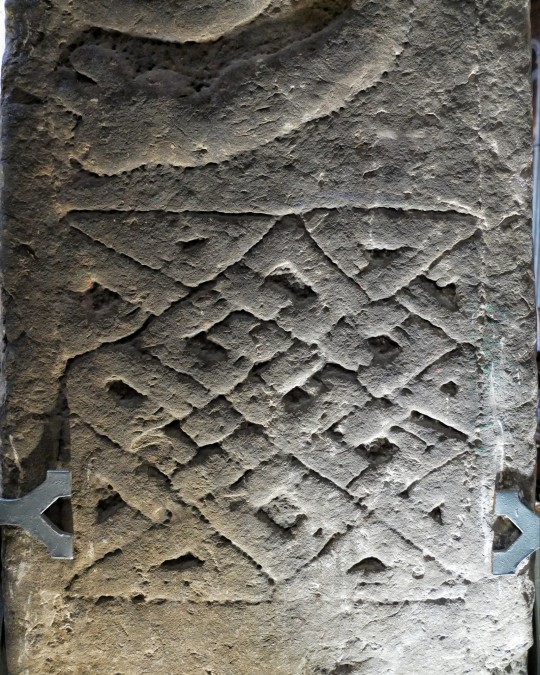


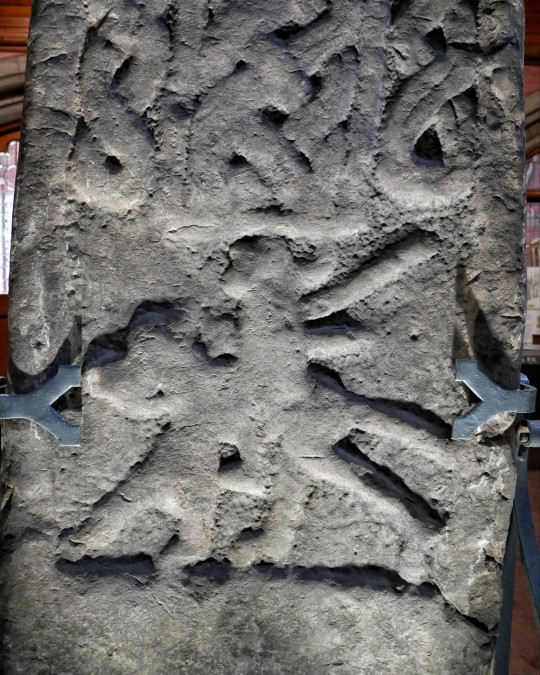

'The Sun Stone', Early Christian Cross with Pictish Influenced Design, Govan Old Stones Collection, Old Govan, Glasgow, Scotland
#early religion#Pictish#pict#picts#archaeology#ancient living#ancient craft#ancient culture#symbols#sun#sun motif#stonework#stone carving#Scotland#Glasgow#early christianity#cross shaft
485 notes
·
View notes
Text
Last night I dreamed that a guy was carving long grooves into my shins to fill them with ink, and it hurt like hell, but when I sat up to look, my legs were covered with gorgeous green-black lines and geometry and bizarre little pictish animals, and I woke up sad when I remembered my legs were still bare.
4 notes
·
View notes
Note
May I have a Friday fun fact?
Today You Learned about the Pictish Beast!
In Scotland, there was a group of people called the Picts. Contrary to what you probably think, it’s unlikely they tattoed themselves with woad to look blue, because scientists tried it out and found out it makes a crappy tattoo material. And they did a lot of cool carvings that they left around Scotland, still being found today! Like this:


Some of them have carvings of animals, like wolves, or horses, or boars. Cool stuff. Except that they also sometimes have this thing:

What the eff is that? Well, in truth–we don’t know. It’s just some creature. What makes this stranger is that while there are some more symbolic images, overall, the Picts were pretty good at carvings of animals–all of them you can tell quite clearly what they are. But the Pictish Beast is just some weird critter. And it keeps popping up! So it must have been something culturally important, but we haven’t a clue what.
There are a lot of random guesses I’ve heard over the years, including:
-A seahorse. -An elephant. -A dolphin. -A kelpie. -The Loch Ness Monster. -Some unknown, mythical creature from the long-dead Pictish religion we’ve never heard of. -A stylized animal-shaped brooch.
[shrugs] Who knows, man.
24 notes
·
View notes
Note
I think my favourite fiction of yours is the Summoning. It's written beautifully. I adore that love Alasdair bears for Matt, enough to raise the dead and ask the impossible. And the gulf between him and his mother is so tenderly painful. The layers of formality; the misunderstandings of time. It's perfect. I have to ask though: do Rhys and Arthur follow through on her request (or does Alasdair keep the visit to himself?)
AWW thank you! That was honestly one of the best things I've ever written. Being outside of time but also so anchored in this 17th century world where everything is fire, blood and witchcraft carved out of them all. Eirian is there, a shadow of who she was, existing in the nightlands, this land of the dead only to occasionally walk between worlds and into the realm of the living because the only thing that can are ideas, and love might be the strongest idea there is.
And they do! Not specifically because he relayed that message, I think he might have kept that to himself because their world is one where by and large, any attachment is a screaming weakness. Brighid, Alasdair and Rhys have a somewhat easier time connecting with their mother, they could probably do it semi-regularly just to catch up if they wanted. They still speak languages that descend from hers, the celtic fringe that survives every day. Pictish, probably closer related to Welsh and Cumbric than Gaelic, was kind of torn from him in late antiquity and the early middle ages but it was replaced by Gaelic, his form of what was Brighid's language. Those three are kind of laced into each other. Invasions and counter invasions, defined by degrees of alienation from the imperial core that Arthur represents.
Arthur's inheritance is largely dead. His people never were completely usurped by the Germanic speaking peoples who formed England, but the words are gone, with only a handful remaining for him to use to name things he loves in at least a twisted way, the way his mother loved him. So its harder, I think, to look that far into the past, that far beyond the world Arthur had more hand in shaping than maybe the rest of them combined. He, like his siblings sees his mother in whatever space-time exists between this life and the next. She's a part of the tether that keeps them constantly on the balance between human and not, alive and not, real and not. The only difference being that it's the main way he sees her because dying is so much easier than unlocking things he could feel and speak in a language gone from this world. His mother is almost entirely reserved for those places. When crushed into the depths by a shipwreck under unfathomable pressure, rolling out of a plague cart, looking up at the heavens from some godforsaken rock of his second son or second empire. He sees her in the places where his arrogance and his over confidence has laid him bare to human consequences of cold, exposure and hunger. Mirages of what the Romans named barbaric when the image of 'civilization' Arthur imposes on the world everyone else tears him to shreds.
#the ask box || probis pateo#britannia and her children || they made a desert and called it peace#meatsack mechanics || the sociology and biology of nations#why i write
20 notes
·
View notes
Text

On the way back from Torridon, we took a detour into Strathpeffer for a quick look at the Eagle Stone, so named - obviously - for the eagle carved on it below the 'horseshoe', another common Pictish symbol.
Its Gaelic name, Clach an Tiompain, doesn't actually mean 'Eagle Stone' - that would be something like Clach na h-Iolaire, though I'll admit I'm not certain of the grammar. I'm not totally sure what it does mean; Wikipedia says 'the Sounding Stone', but I'm not altogether confident of that translation.
6 notes
·
View notes